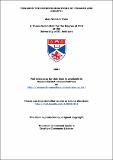Files in this item
Towards the microfoundations of finance and growth
Item metadata
| dc.contributor.advisor | Nolan, Charles | |
| dc.contributor.advisor | Shea, Gary Stephen | |
| dc.contributor.author | Trew, Alex | |
| dc.coverage.spatial | xii, 232 p. | en |
| dc.date.accessioned | 2007-05-30T15:38:45Z | |
| dc.date.available | 2007-05-30T15:38:45Z | |
| dc.date.issued | 2007-06-20 | |
| dc.identifier | uk.bl.ethos.552007 | |
| dc.identifier.uri | https://hdl.handle.net/10023/331 | |
| dc.description.abstract | We take a critical view of the standard approach to finance and growth. The mapping between the theory and empirics is shown to be poorly understood, and this is traced to deficiencies in our understanding of the microeconomics at play. By looking at both primary and secondary historical evidence we argue that issues of aggregation are critical, and that spatial factors are also prevalent. Further, we suggest that these disaggregated elements can change over the course of an industrial revolution. A model in the spirit of standard finance and growth theories is extended to consider these further effects, and we calibrate the model to data on historical growth paths. In order to advance our understanding of the microeconomic factors that cause the observed phenomena in the finance-growth nexus, we develop a general equilibrium theory of financial intermediation in which exchange costs are endogenously determined by technologies, endowments and preferences. We suggest that incomplete contracts might be central to these phenomena. We link this framework to an understanding of power and political economy in a setting with heterogeneous agents. We develop these results numerically, showing a number of interesting interactions between markets, exchange costs and institutions in economies with different levels of wealth. The model of endogenous exchange costs can be thought of in terms of the findings coming out of our historical analysis. We outline in some detail the further steps that need to be taken before we can speak of the microfoundations of finance and growth with any confidence. First, a fully dynamic model of markets and coalitions must be embedded within a story of economic growth that can match the dynamic observations. Second, we must develop our conception of incomplete contracting and the link with institutions and political economy. The thesis thus opens a number of interesting avenues for future research. | en |
| dc.format.extent | 1788216 bytes | |
| dc.format.mimetype | application/pdf | |
| dc.language.iso | en | en |
| dc.publisher | University of St Andrews | |
| dc.rights | Creative Commons Attribution-NonCommercial-NoDerivs 3.0 Unported | |
| dc.rights.uri | http://creativecommons.org/licenses/by-nc-nd/3.0/ | |
| dc.subject | Finance and growth | en |
| dc.subject | Economic history | en |
| dc.subject | Institutions | en |
| dc.subject | Exchange costs | en |
| dc.subject | Incomplete contracts | en |
| dc.subject.lcc | HB172.T8 | |
| dc.subject.lcsh | Finance | en |
| dc.subject.lcsh | Economic development | en |
| dc.subject.lcsh | Microeconomics | en |
| dc.subject.lcsh | Incomplete contracts | en |
| dc.subject.lcsh | Economic history | en |
| dc.title | Towards the microfoundations of finance and growth | en |
| dc.type | Thesis | en |
| dc.contributor.sponsor | Centre for Dynamic Macroeconomic Analysis | en |
| dc.contributor.sponsor | Shell Foundation | |
| dc.type.qualificationlevel | Doctoral | en |
| dc.type.qualificationname | PhD Doctor of Philosophy | en |
| dc.publisher.institution | The University of St Andrews | en |
| dc.publisher.department | Centre for Dynamic Macroeconomic Analysis | en |
This item appears in the following Collection(s)
Except where otherwise noted within the work, this item's licence for re-use is described as Creative Commons Attribution-NonCommercial-NoDerivs 3.0 Unported
Items in the St Andrews Research Repository are protected by copyright, with all rights reserved, unless otherwise indicated.


